The Intel Xeon 6 family of server CPUs was launched a few weeks back, replacing the former “Scalable” branding. There are two lines of chips: Sierra Forest, which offers E cores, and Granite Rapids, which offers P cores. In this review, we’ve sampled a few early sets of Sierra Forest CPUs, including the top-end 6780E, which brings 144 cores to market.
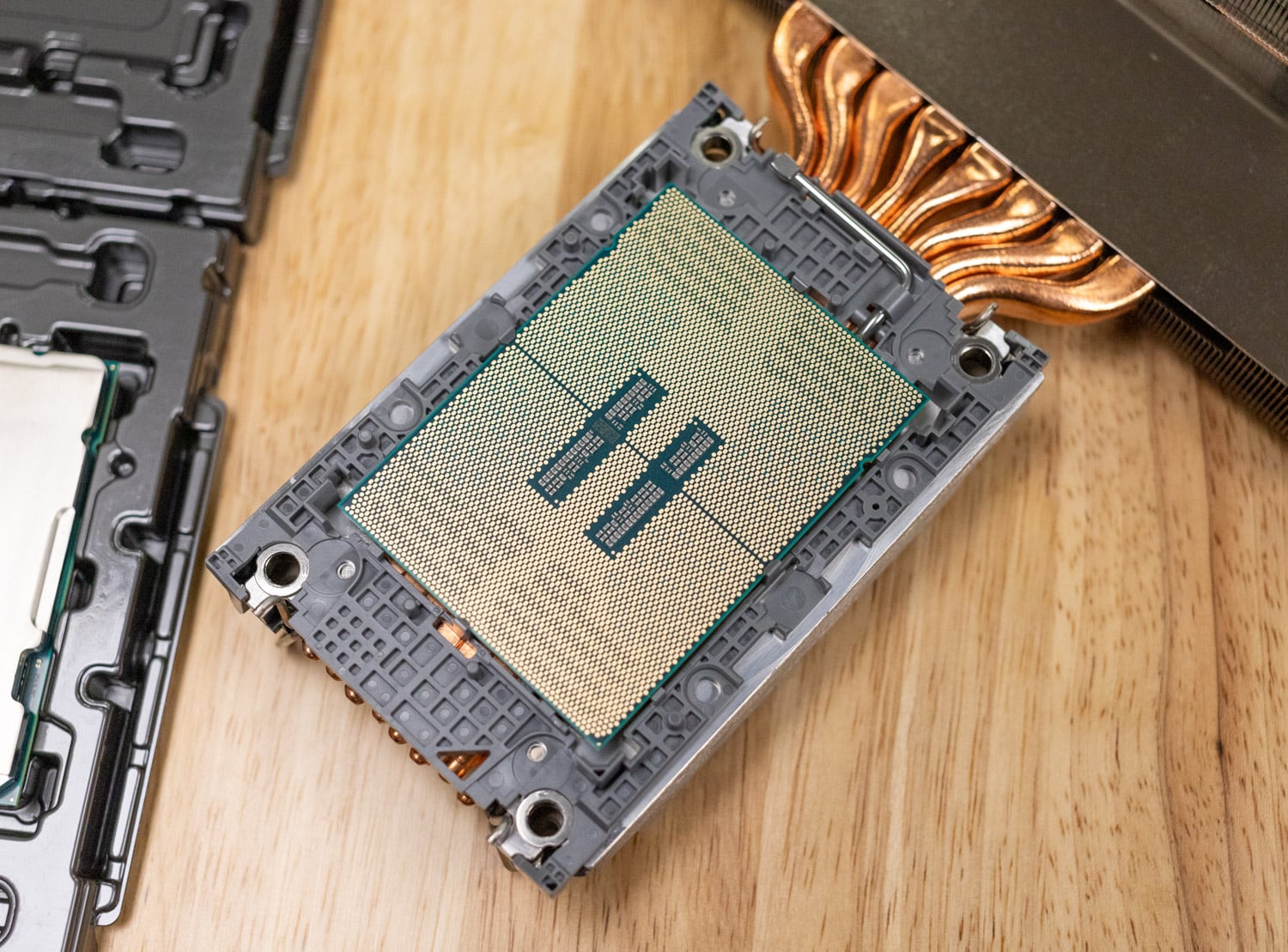
Xeon 6 CPUs are designed to support essentially every workload, from the obvious AI use cases all the way to less demanding deployments at the edge. To help customers understand the two swim lanes, Intel indicates Sierra Forest is “Optimized for performance-per-watt in high-density compute and scale-out workloads.” The P-core Granite Rapids CPUS is “Optimized for per-core-performance in compute-intensive workloads.” All of the Xeon 6 CPUs, though, use a common platform and firmware stack.
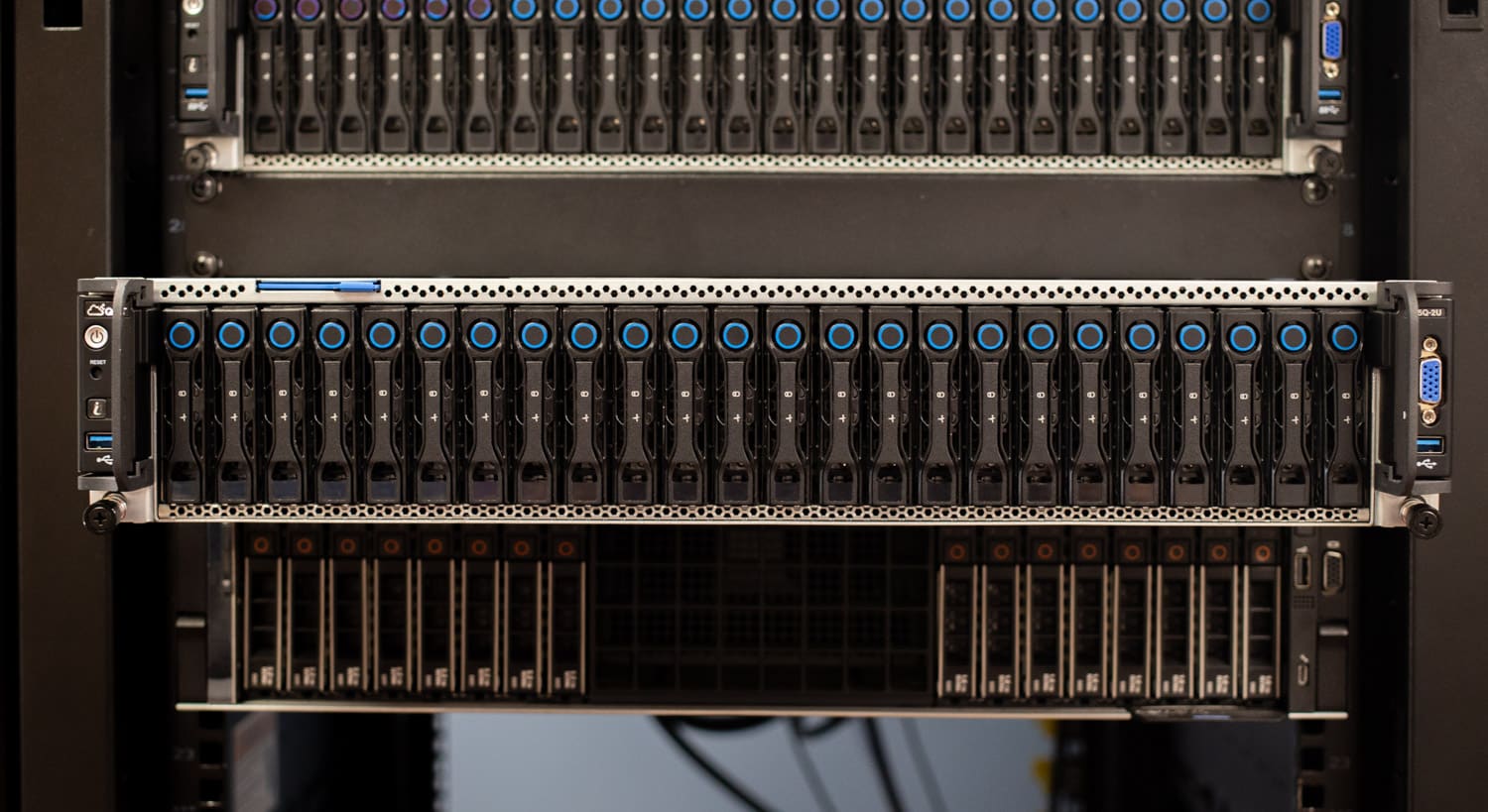
To give a little more context on the CPUs’ performance, Intel is positioning Sierra Forest as a great replacement for systems hitting a 5-year refresh cycle. In that case, the performance-per-watt figures should be dramatically more favorable.
The Xeon 6 rollout will be staged, with the 6700E family launching today. But there’s much more to come. The Intel Xeon 6900P CPUs are scheduled to drop this year in Q3. We expect to see a deluge of chips, including the 6900E, 6700P, 6500P, Xeon 6 SoC, and 6300P, during Q1 2025.
Architectural Innovations
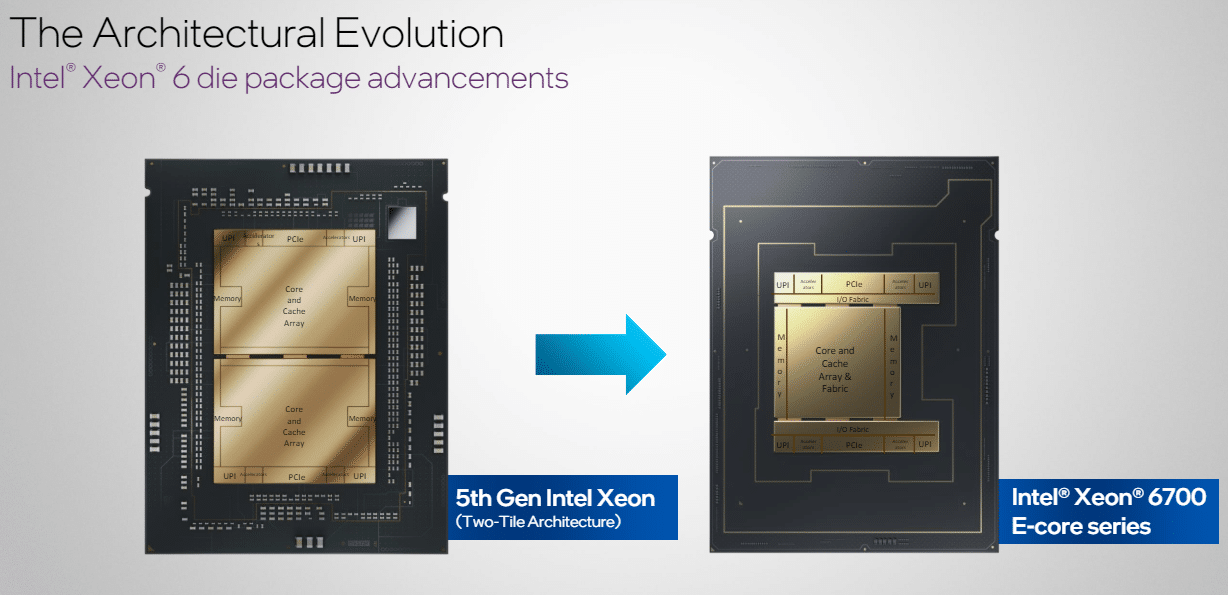
The Xeon 6 introduces two microarchitecture designs, a Performance-optimized cores (P-cores) and an Efficiency-optimized cores (E-cores) platform. This hybrid approach allows data centers to design a rack where compute-intensive workloads, such as AI and HPC, benefit from maximum performance while throughput-oriented tasks, like microservices and networking, achieve a new level of energy efficiency.
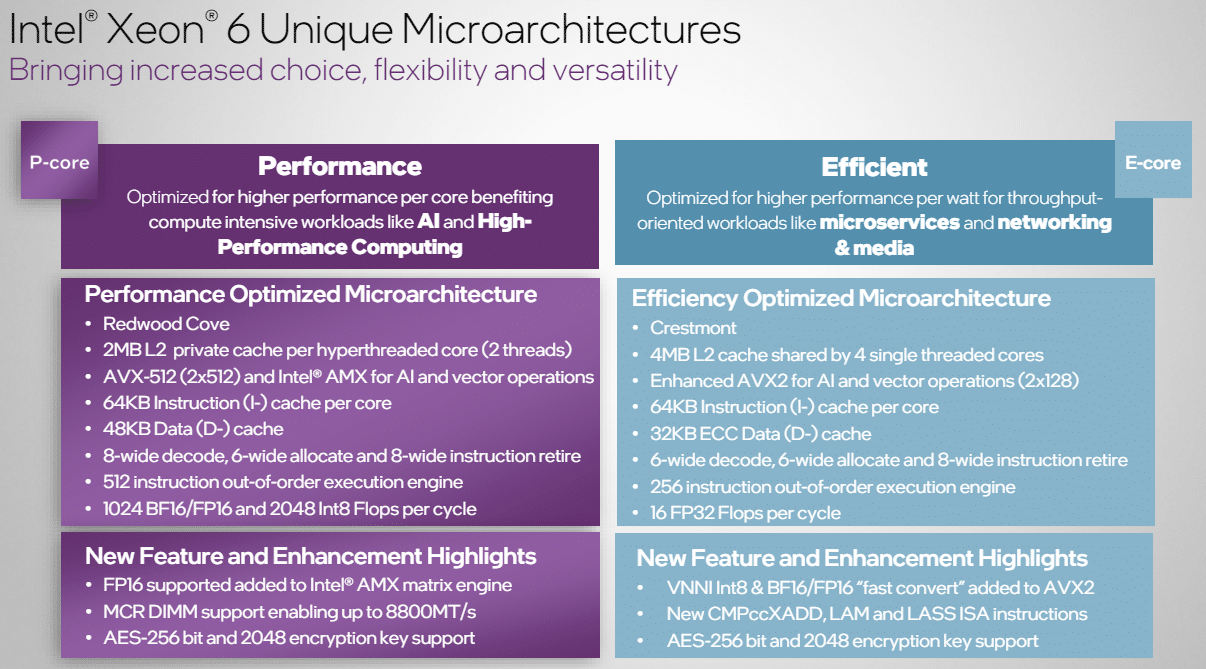
Increased Core Counts
The headline feature of the Xeon 6 Sierra Forest processors is the significant increase in core counts. By integrating more cores per processor, Intel enables data centers to handle a broader array of workloads simultaneously. This increase in core density is particularly beneficial for applications that require high levels of parallel processing, ensuring that resources are used optimally to maximize throughput and minimize latency.
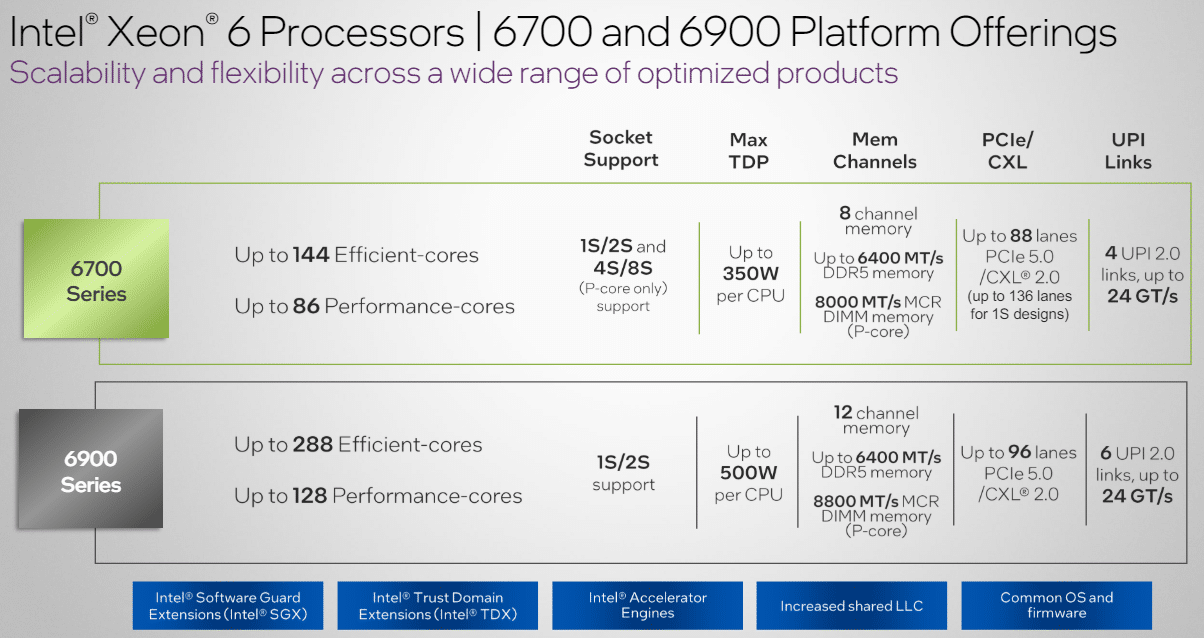
Enhanced Memory Bandwidth
For a few generations, it feels like we have been stuck with slower server DRAM speeds as the consumer market has rocked to well over 7000MT/s. The integration of DDR5 memory with Ultra Path Interconnect (UPI) 2.0 in the Xeon 6 Sierra Forest processors significantly enhances memory bandwidth. This allows for faster data access and reduces bottlenecks, ensuring that high-performance applications can run smoothly. The improved memory bandwidth is critical for applications that handle large datasets and require rapid data retrieval and processing, such as AI training and big data analytics.
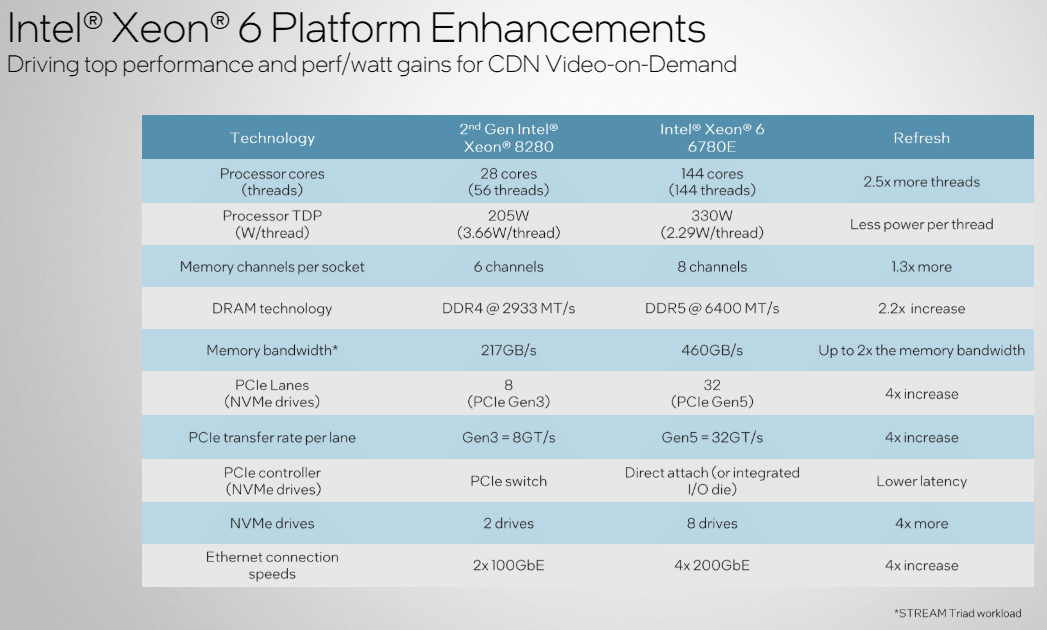
Intel Xeon 6 Advanced I/O Capabilities
Support for PCIe 5.0 and Compute Express Link (CXL) 2.0 provides the Xeon 6 Sierra Forest processors with advanced I/O capabilities. PCIe 5.0 offers double the bandwidth of its predecessor, enabling faster communication between the processor and peripheral devices. CXL 2.0 further enhances connectivity by providing a high-bandwidth, low-latency interconnect for processors, accelerators, memory, and storage. This ensures that data centers can meet the demands of modern high-speed applications and can integrate seamlessly with future technologies.
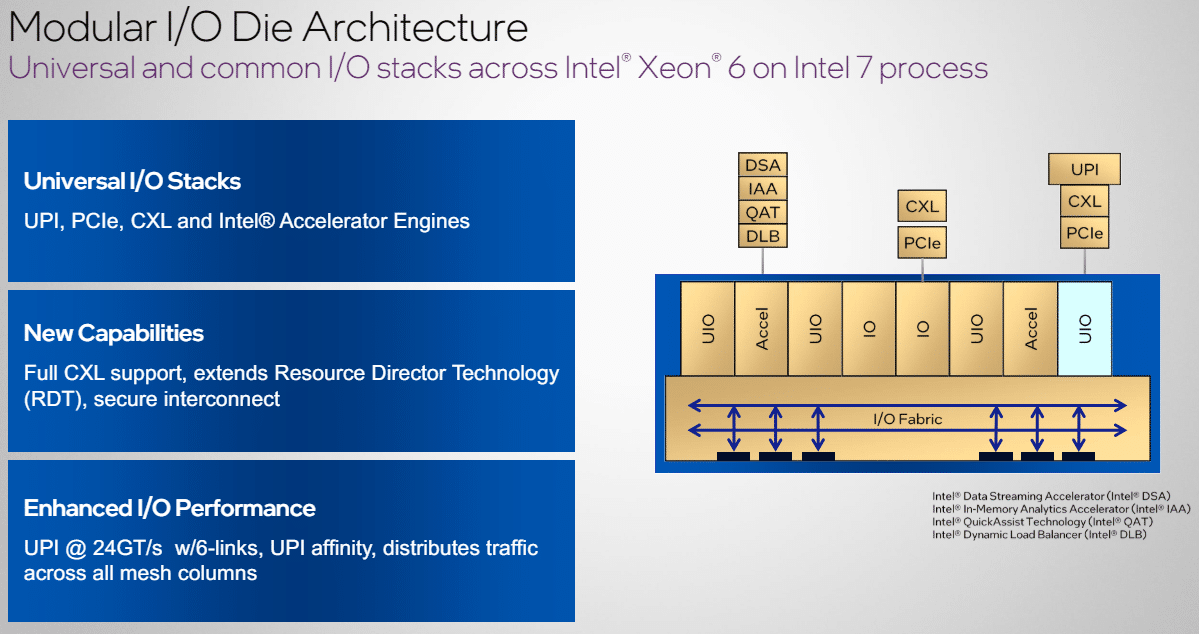
Modular Multi-die Architecture
The Xeon 6 Sierra Forest processors utilize a modular multi-die architecture enabled by Embedded Multi-die Interconnect Bridge (EMIB) technology. This design allows for the combination of multiple dies in a single package, providing high bandwidth and low latency while maintaining efficient power consumption. The modular approach offers flexibility and scalability, allowing data centers to customize their infrastructure to meet specific workload requirements. This architecture also supports better thermal management and power efficiency, which are critical for maintaining performance and reliability in high-density environments.
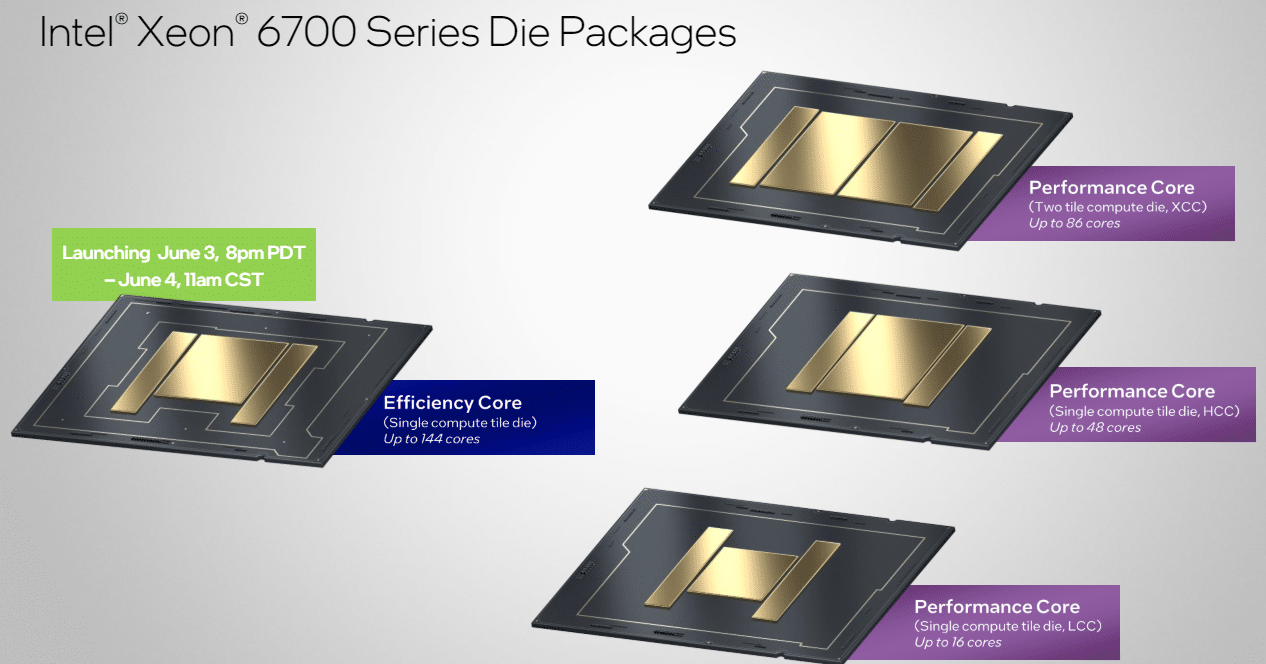
Intel Xeon 6 Die Architecture
The die architecture of the Xeon 6 Sierra Forest processors is an interesting insight into Intel’s innovative approach to maximizing performance and efficiency. Unlike a traditional large silicon interposer, EMIB implements a small bridge die with multiple routing layers. By leveraging EMIB technology, Intel can interconnect multiple dies within a single package, reducing the overall package size and enhancing signal integrity. This configuration allows for faster data transfer rates between the dies, which is essential for maintaining high performance across a wide range of applications.
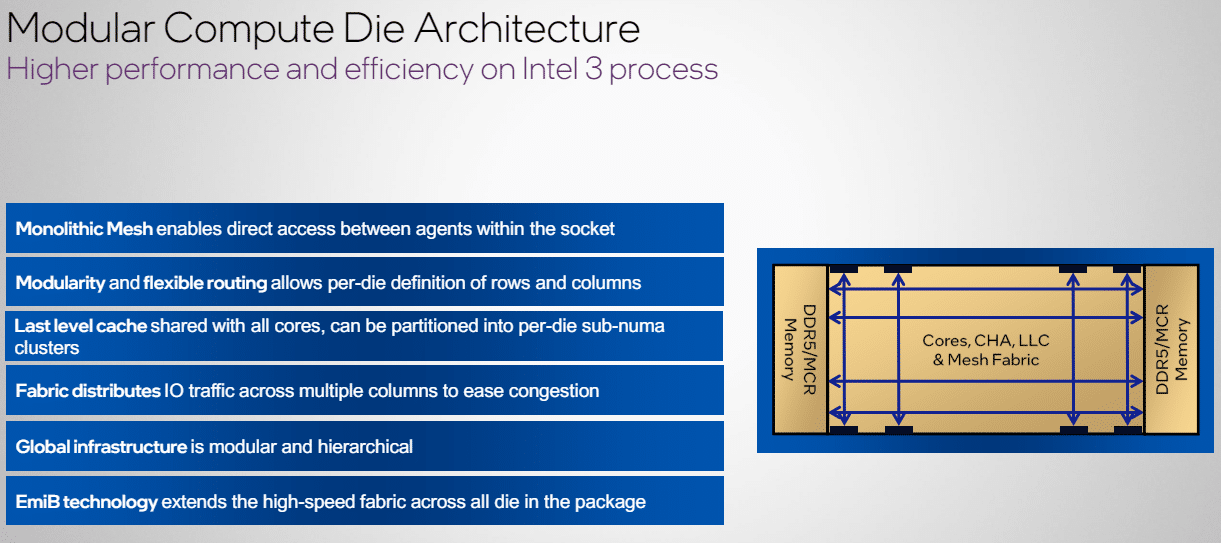
Importance for Datacenters
Performance and Efficiency
Compared to previous generations, Xeon 6 processors offer up to 2.7x higher performance per watt, making them ideal for AI inference, media transcoding, and general compute tasks. This balance ensures data centers can handle more workloads with lower energy consumption, directly translating to reduced operational costs and improved sustainability.
Scalability and Flexibility
The modular architecture allows data centers to customize their infrastructure based on specific workload demands. The ability to deploy a mix of P-cores and E-cores across platforms provides a tailored approach to managing diverse computing needs, enhancing both performance and efficiency. This presents an interesting concept where one chassis can be selected and then deployed, with some having E-core CPUs available to efficiently run core services and handle operations at less demanding times, while others are outfitted with P-core CPUs to handle peak demand and demanding workloads.
Enhanced Security and Reliability
Built with hardware-enhanced security features, Xeon 6 processors offer robust protection for data integrity and system reliability. This is critical for maintaining trust and compliance in data-sensitive environments.
Future-proofing with Advanced Technologies
With support for the latest technologies like DDR5, PCIe 5.0, and CXL 2.0, Xeon 6 processors ensure data centers are ready for future advancements and can seamlessly integrate with emerging hardware and software solutions.
Modern Solutions for Modern Problems
The Intel Xeon 6 Sierra Forest processors represent a major leap forward in data center architecture. By combining high performance, energy efficiency, and scalability, they address the multifaceted needs of modern data centers, paving the way for enhanced operational efficiency, reduced costs, and the ability to handle the increasing demands of AI and other compute-intensive applications.
Intel Xeon 6 E-core SKU Map
All of the Sierra Forest SKUs feature E-Cores with 88 lanes of PCIe Gen5/CXL.
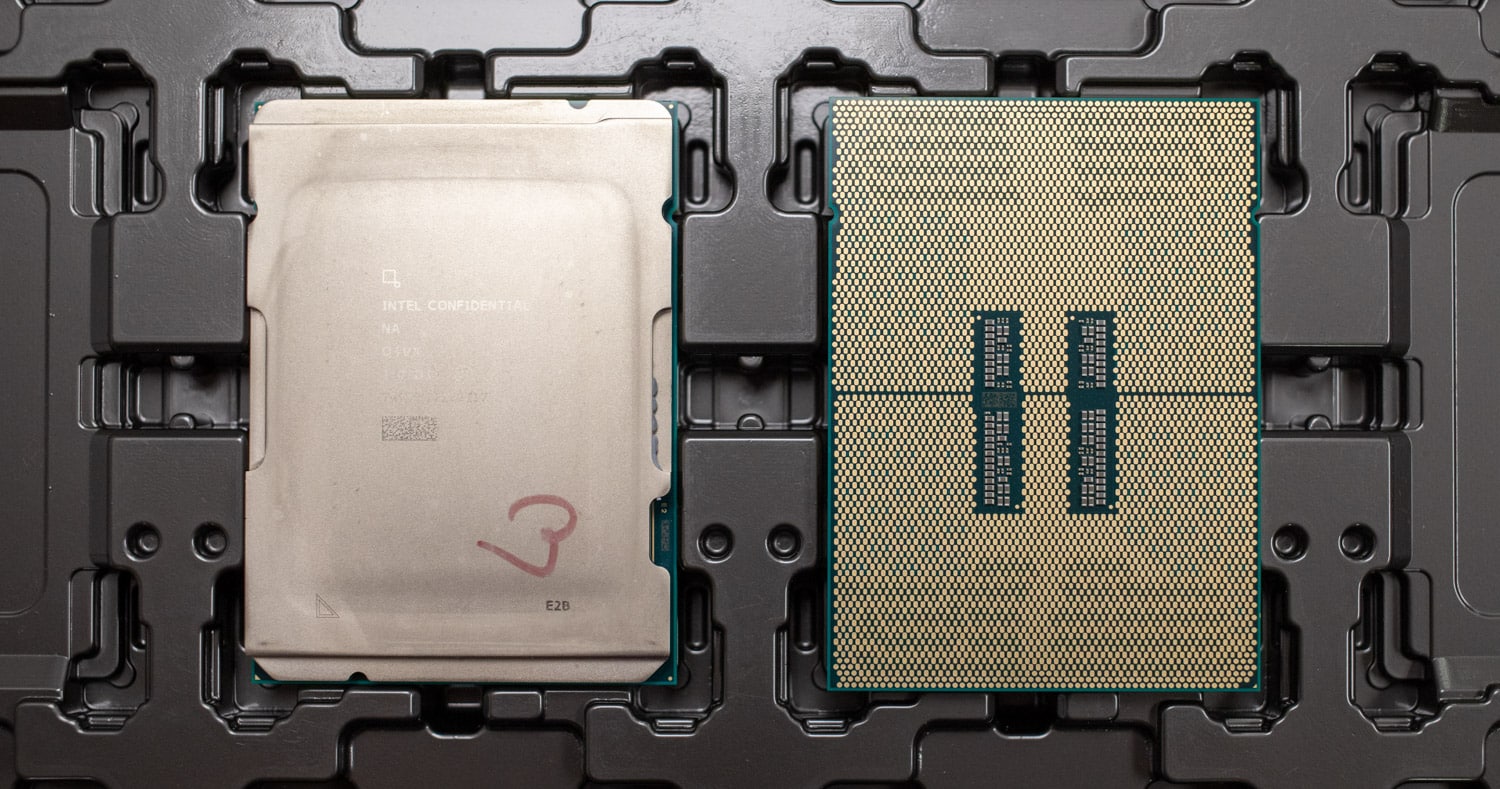
| SKU | Cores | Base GHz | Turbo GHz | Max Turbo GHz | L3 Cache MB | TDP Watts | Max Scala. | DDR5 Mem Speed 1DPC |
|---|---|---|---|---|---|---|---|---|
| 6780E | 144 | 2.2 | 3.0 | 3.0 | 108 | 330 | 2S | 6400 |
| 6766E | 144 | 1.9 | 2.7 | 2.7 | 108 | 250 | 2S | 6400 |
| 6756E | 128 | 1.8 | 2.6 | 2.6 | 96 | 225 | 2S | 6400 |
| 6746E | 112 | 2.0 | 2.7 | 2.7 | 96 | 250 | 2S | 5600 |
| 6740E | 96 | 2.4 | 3.2 | 3.2 | 96 | 250 | 2S | 6400 |
| 6731E | 96 | 2.2 | 3.1 | 3.1 | 96 | 250 | 1S | 5600 |
| 6710E | 64 | 2.4 | 3.2 | 3.2 | 96 | 205 | 2S | 5600 |
Intel Xeon 6 Performance Testing
Our lab was sampled two sets of CPUs for this review, the 6780E and 6766E. Intel provided a QCT server platform for testing. We want to note a few key caveats in our data. The server platform itself was unstable in many of our test environments. For instance, it would not properly run Windows Server 2022, so we used 2025.
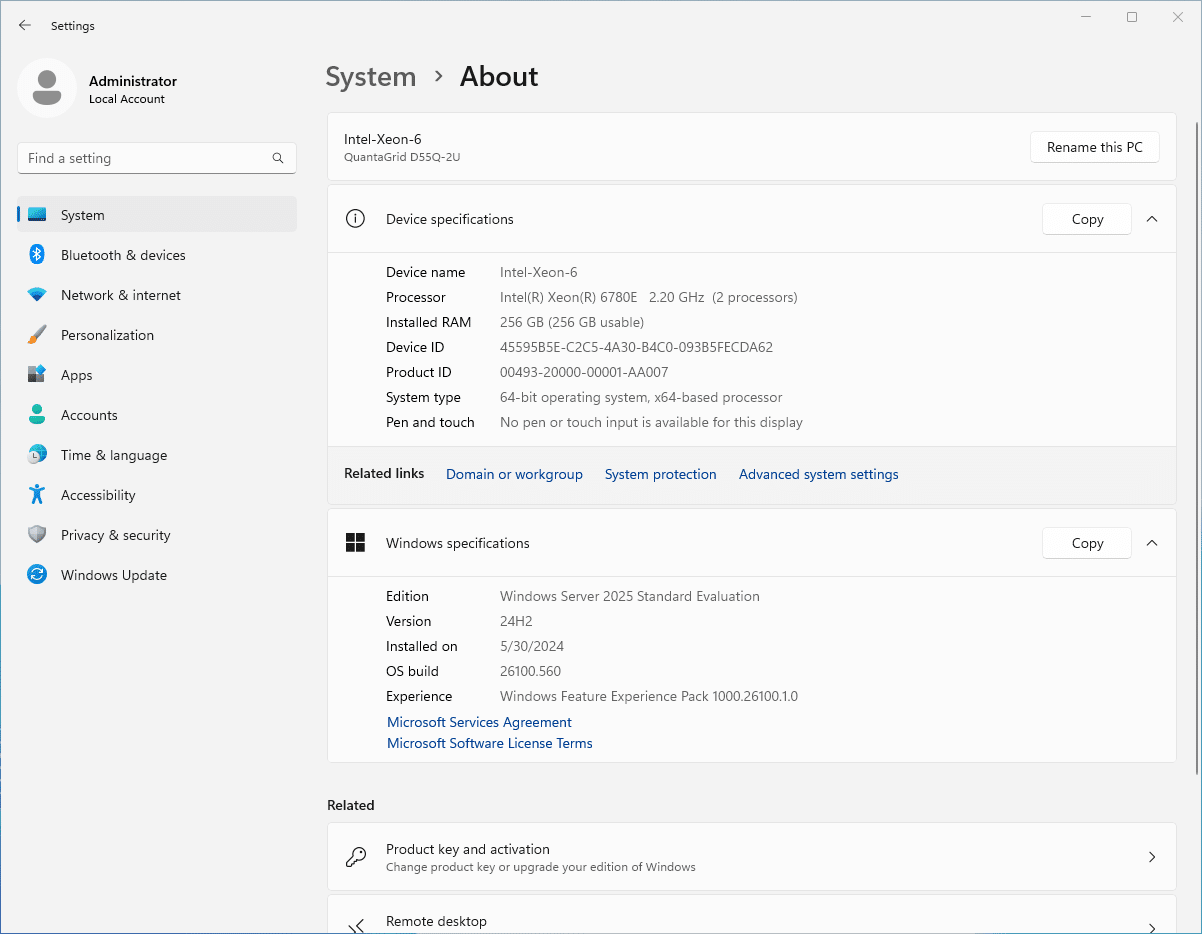
The CPUs are early samples and not new-in-box retail CPUs. As such, we were unable to run our full battery of tests and haven’t had time ahead of the embargo drop to properly root cause some of the issues, performance, and stability that we’re seeing. As such, the following data should be taken as instructional and not final. We’ll wait for shipping platforms from Intel’s OEMs before issuing a more conclusive judgment on the capabilities of the Sierra Forest CPUs.
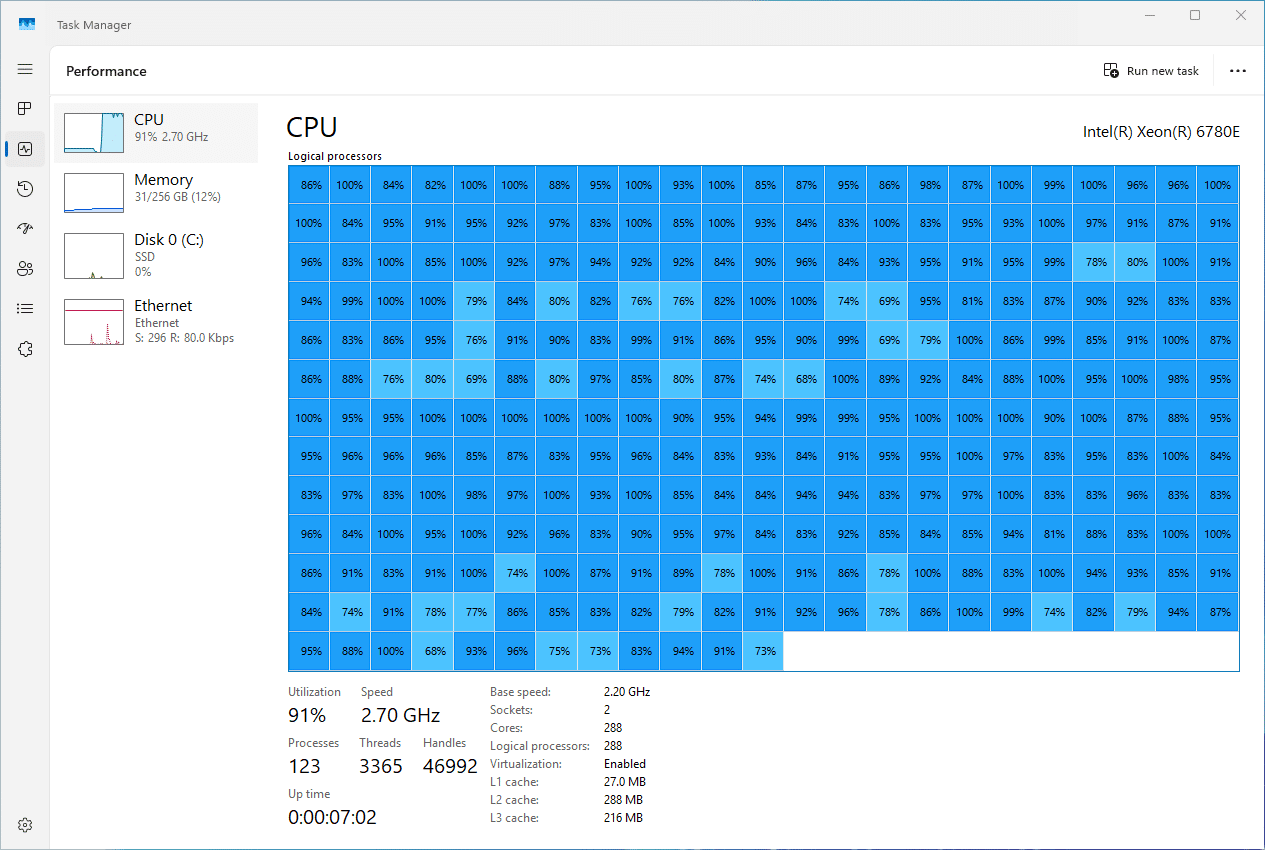
Intel shipped us a Quanta QuantaGrid D55Q-2U system as a test platform to showcase the new CPUs. This server offers a 24-bay NVMe direct-attached backplane supporting U.2 Gen4/Gen5 SSDs.
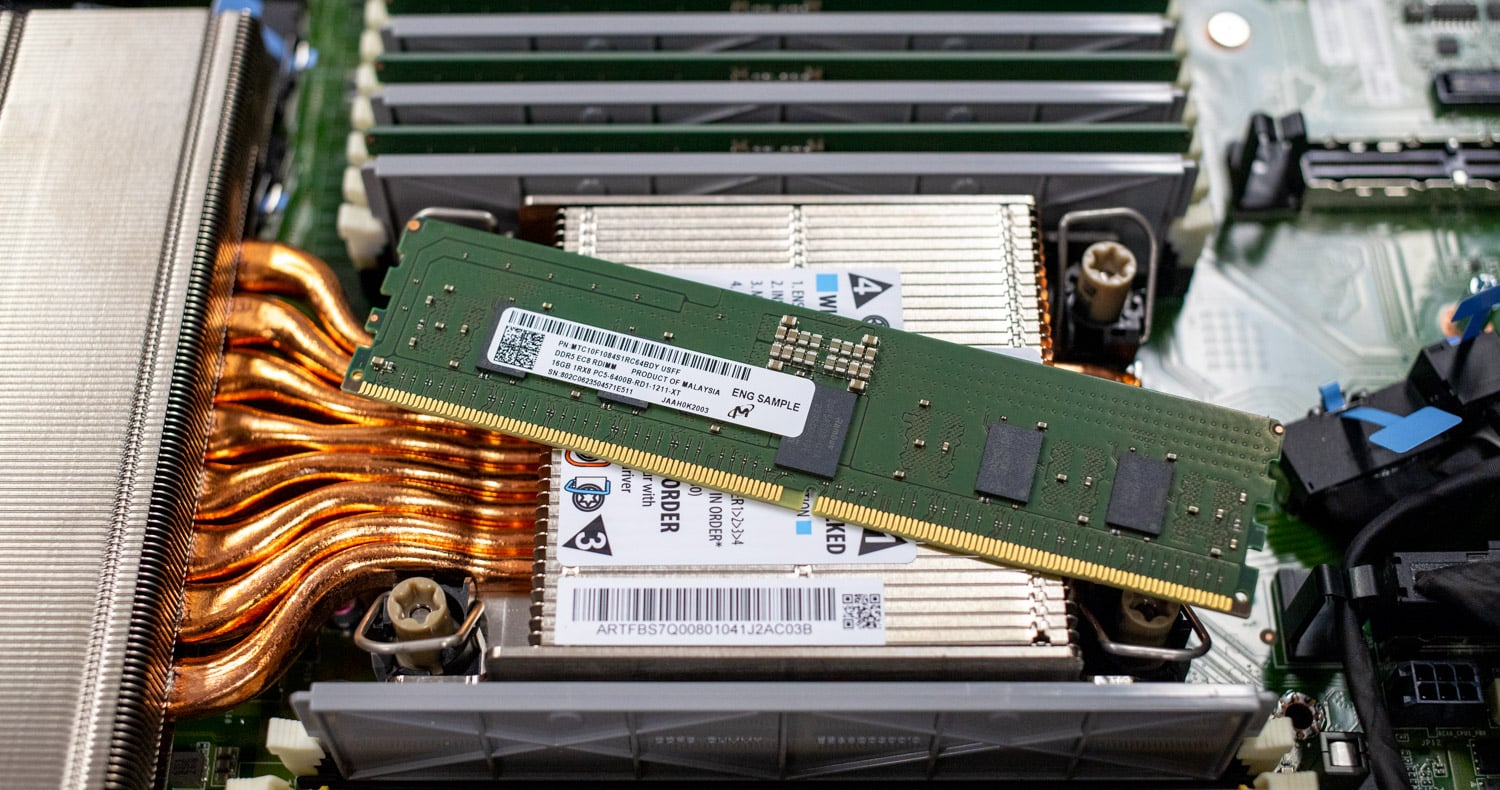
Our test configuration included 16 x 16GB DDR5-6400 RAM and included Micron MTC10F1084S1RC64BDY modules
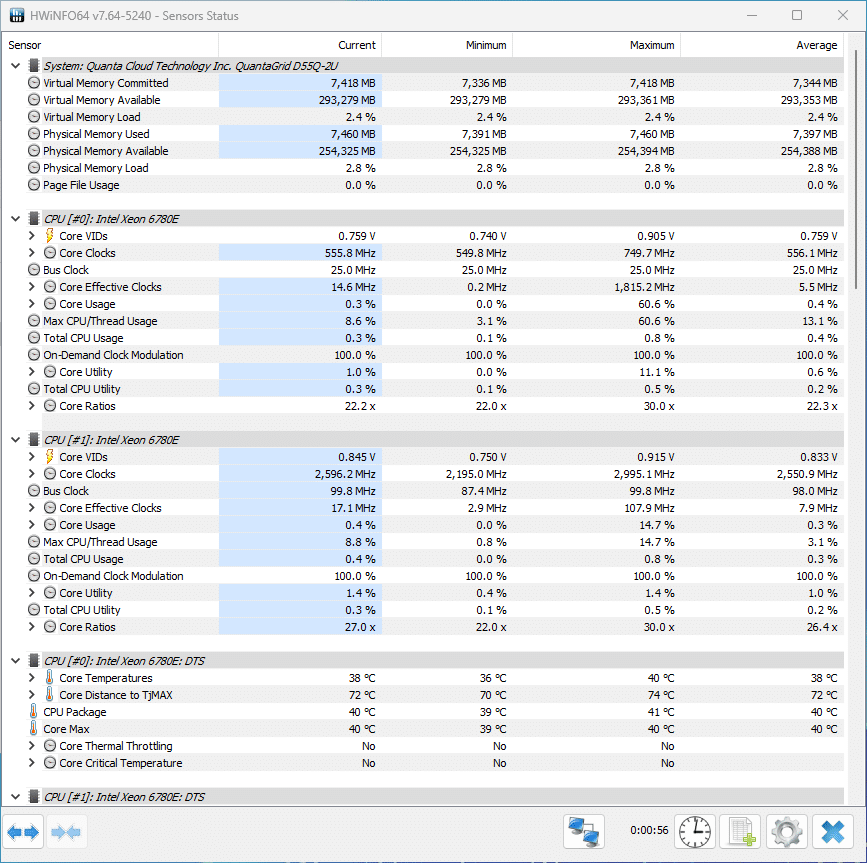
Xeon 6780E and Xeon 6766E
- Quanta QuantaGrid D55Q-2U
- 256GB DDR5 6400MHz
Xeon Platinum 8592+
- Dell Poweredge R760
- 1TB DDR5 4800MHz
Xeon Gold 6430
- Dell Poweredge R760
- 1TB DDR5 4800MHz
Xeon Platinum 8480+
- HP ML350 Gen 11
- 256GB DDR5 4800MHz
With the very early test platform gremlins in play, the new Xeon 6780E and 6766E CPUs were tested inside a Windows Server 2025 environment, while past CPUs were tested inside Windows Server 2022.
Blender OptiX 4.0
In Blender OptiX, we have 3 different tests: Monster, Junkshop, and Classroom. For Monster, we saw the 6780E and 6766E overtake the 8592+ by 21% and 14%, with an 18% difference between the two. On Junkshop the 6780E was ahead of the 8592+ by 10.5%, with the 6766E behind the 8592+ by only 0.35%. There was a 10.8% difference between the 6780E and 6766E on Junkshop. For the Classroom portion, the 6780E and 6766E jumped ahead of the 8592+ by 20% and 22% with a 10% difference between the 6780E and 6766E.
| Blender 4.0 CPU | 2x Xeon 6780E (256GB DDR5) | 2x Xeon 6766E (256GB DDR5) | 2x Xeon Platinum 8592+(ER) (R760 – 1TB DDR5 4800MHz) | 2x Xeon Platinum 8480+(SR) (ML350 G11 – 256GB DDR5 4400MHz) | 2x Xeon Gold 6430(SR) (R760 – 1TB DDR5 4800MHz) |
|---|---|---|---|---|---|
| Monster | 1410.463 | 1297.715 | 1115.057 | 943.300 | 540.039 |
| Junkshop | 862.418 | 777.716 | 780.408 | 627.662 | 361.066 |
| Classroom | 696.543 | 628.960 | 556.550 | 475.144 | 278.228 |
Cinebench R23
For Cinebench R23, the Multi-Core performance showed the 6780E and 6766E behind the 8592+ by 38% and 42%, respectively. For single-core performance, the 6780E was 24% behind the 8592+, and the 6766E was 31% behind. The difference between the 6780E and 6766E fell around 5% for the multi-core score and 18% for single-core
| Cinebench R23 | 2x Xeon 6780E (256GB DDR5) | 2x Xeon 6766E (256GB DDR5) | 2x Xeon Platinum 8592+(ER) (R760 – 1TB DDR5 4800MHz) | 2x Xeon Platinum 8480+(SR) (ML350 G11 – 256GB DDR5 4400MHz) | 2x Xeon Gold 6430(SR) (R760 – 1TB DDR5 4800MHz) |
|---|---|---|---|---|---|
| CPU Multi Core | 67,984 | 64,326 | 110,498 | 79,164 | 69,663 |
| CPU Single Core | 873 | 793 | 1,144 | 1,461 | 1,022 |
| MP Ratio | 77.91x | 81.10x | 96.63x | 54.20x | 68.17x |
Cinebench 2024
For Cinebench 2024, the multi-core score saw about a 55% drop from the 8592+ to the 6780E and a 61% drop from the 8592+ to the 6766E. This also carried a 13% difference between the 6780E and 6766E on Multi-Core. For single-core scores, the 6780E and 6766E only had a 5% difference, with the 6780E and 6766E falling 37% and 34% respectively behind the 8592+.
| Cinebench R23 | 2x Xeon 6780E (256GB DDR5) | 2x Xeon 6766E (256GB DDR5) | 2x Xeon Platinum 8592+(ER) (R760 – 1TB DDR5 4800MHz) | 2x Xeon Gold 6430(SR) (R760 – 1TB DDR5 4800MHz) | 2x Xeon Platinum 8480+(SR) (ML350 G11 – 256GB DDR5 4400MHz) |
|---|---|---|---|---|---|
| CPU Multi Core | 2,687 | 2,347 | 6,001 | 3,746 | 4,699 |
| CPU Single Core | 43 | 45 | 68 | 59 | 76 |
| MP Ratio | 62.85x | 52.65x | 88.48x | 63.22x | 61.44x |
Y-Cruncher
Y-cruncher is a popular benchmarking and stress-testing application that launched back in 2009. This test is multi-threaded and scalable, computing Pi and other constants up to the trillions of digits. Faster is better in this test.
The new 6780E and 6766E run a little slower than the Emerald Rapids 8592+, but they aren’t exactly direct competitors. The 6780E ran roughly 13% faster than the Xeon Gold 6430 for the 1 Billion test but roughly 39% slower than the Xeon Platinum 8592+. The 6766E ran 19% slower than the Gold 6439 and 42% Slower than the Platinum 8592+
| Y-Cruncher (lower is better) | Xeon 6780E (256GB DDR5) | Xeon 6766E (256GB DDR5) | 2x Xeon Platinum 8592+(ER) (R760 – 1TB DDR5 4800MHz) | 2x Xeon Gold 6430(SR) (R760 – 1TB DDR5 4800MHz) | 2x Xeon Platinum 8480+(SR) (ML350 G11 – 256GB DDR5 4400MHz) |
|---|---|---|---|---|---|
| 1 Billion | 6.927 seconds | 7.254 seconds | 4.239 seconds | 6.060 seconds | 5.136 seconds |
| 2.5 Billion | 17.898 seconds | 19.507 seconds | 11.466 seconds | 16.896 seconds | 13.768 seconds |
| 5 Billion | 38.454 seconds | 41.116 seconds | 25.325 seconds | 36.843 seconds | 29.889 seconds |
| 10 Billion | 81.146 seconds | 87.403 seconds | 54.921 seconds | 80.574 seconds | 65.194 seconds |
| 25 Billion | 217.530 seconds | 238.813 seconds | 156.923 seconds | 229.017 seconds | 186.841 seconds |
| 50 Billion | 565.913 seconds | 502.245 seconds | N/A | N/A | N/A |
7-Zip
The popular 7-Zip utility has a built-in memory benchmark that demonstrates the CPU performance very well. In this test, we run it at a 128MB dictionary size when possible. In this test, the 6780E just barely crept ahead of the Platinum 8592+ in the total rating. For decompression, the 6766E also made it ahead of the 8592+.
| 7-Zip Compression | Xeon 6780E (256GB DDR5) | Xeon 6766E (256GB DDR5) | 2x Xeon Platinum 8592+(ER) (R760 – 1TB DDR5 4800MHz) | 2x Xeon Gold 6430(SR) (R760 – 1TB DDR5 4800MHz) | 2x Xeon Platinum 8480+(SR) (ML350 G11 – 256GB DDR5 4400MHz) |
|---|---|---|---|---|---|
| Compressing | |||||
| Current CPU Usage | 5,891% | 4,768% | 5,609% | 5,732% | 5,482% |
| Current Rating/Usage | 4.985 GIPS | 4.614 GIPS | 4.912 GIPS | 3.912 GIPS | 4.628 GIPS |
| Current Rating | 293.689 GIPS | 220.001 GIPS | 275,503 GIPS | 224.209 GIPS | 253.724 GIPS |
| Resulting CPU Usage | 5,603% | 5,103% | 5,605% | 5,669% | 5,475% |
| Resulting Rating/Usage | 4.954 GIPS | 4.638 GIPS | 4.883 GIPS | 3.923 GIPS | 4.628 GIPS |
| Resulting Rating | 277.670 GIPS | 236.910 GIPS | 273.716 GIPS | 222.407 GIPS | 253.382 GIPS |
| Decompressing | |||||
| Current CPU Usage | 5,962 GIPS | 5,798% | 6,243% | 5,852% | 6,219% |
| Current Rating/Usage | 4.550 GIPS | 4.152 GIPS | 3.635 GIPS | 3.423 GIPS | 3.745 GIPS |
| Current Rating | 271.266 GIPS | 240.693 GIPS | 226.917 GIPS | 200.350 GIPS | 231.916 GIPS |
| Resulting CPU Usage | 5,832% | 6,029% | 6,232% | 5,894% | 6,129% |
| Resulting Rating/Usage | 4.540 GIPS | 4.161 GIPS | 3.654 GIPS | 3.385 GIPS | 3.871 GIPS |
| Resulting Rating | 264.764 GIPS | 250.853 GIPS | 227.744 GIPS | 199.363 GIPS | 237.259 GIPS |
| Total Rating | |||||
| Total CPU Usage | 5,717% | 5,566% | 5,919% | 5,781% | 5,802% |
| Total Rating/Usage | 4.747 GIPS | 4.399 GIPS | 4.269 GIPS | 3.654 GIPS | 4.249 GIPS |
| Total Rating | 271.217 GIPS | 243.882 GIPS | 250.730 GIPS | 210.363 GIPS | 245.320 GIPS |
Conclusion
The new E-core Intel Xeon 6 lineup, part of the Sierra Forest family, is a change of pace when it comes to review cadence. In past Intel releases, we generally saw the top-end CPUs first; this time around, Intel is leading with the midrange, efficient SKUs.
That said, the Sierra Forest CPUs hold up well, even compared to the prior 5th Gen Scalable models. But the way Intel figures it, customers looking to purchase new hardware are going to compare these to ~5-year-old systems that are being retired, running something like Intel Xeon 8280 CPUs. With those systems as the comp, the E-Core Xeon 6 CPUs offer a massive density and power savings argument.
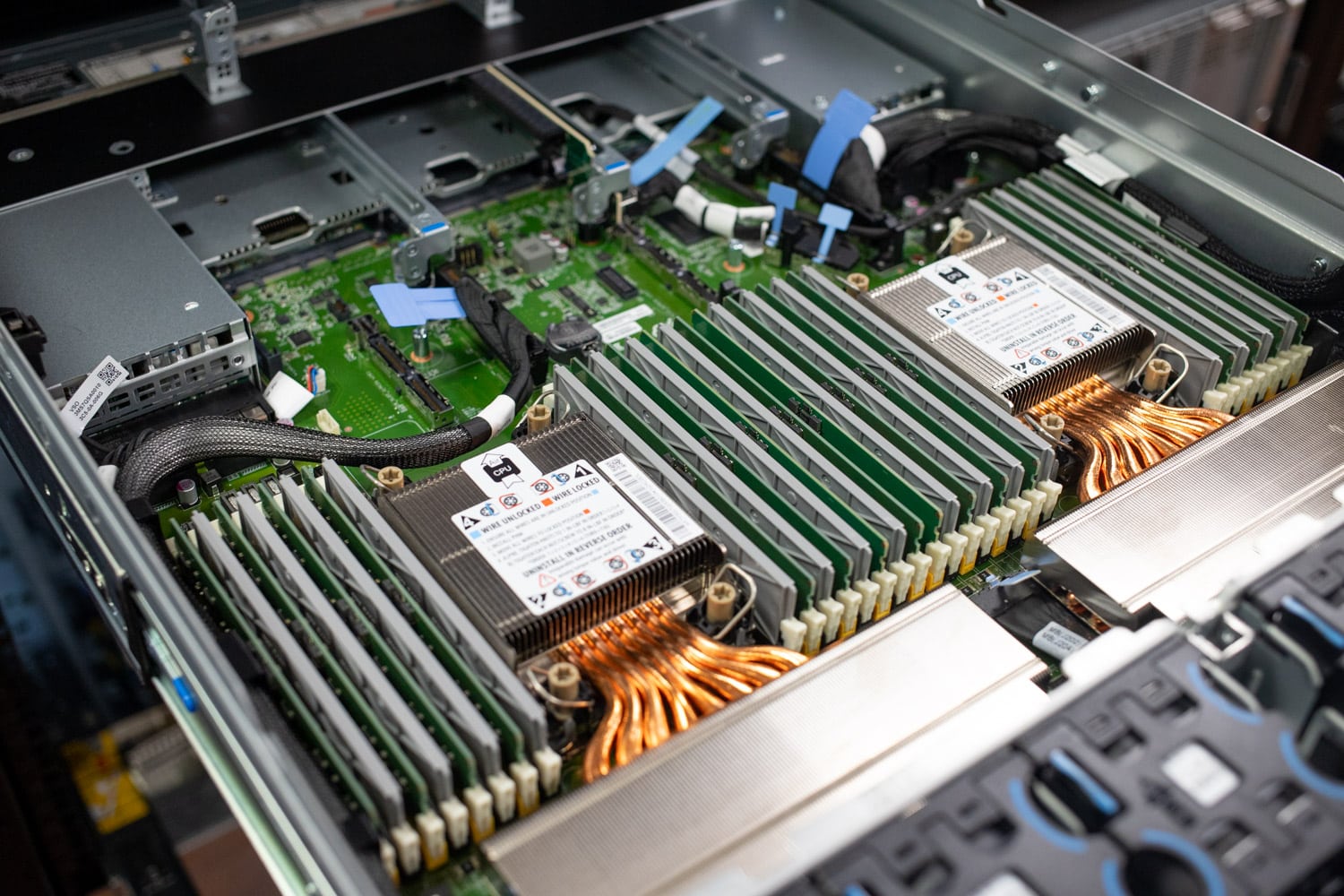
In this review, we’re dealing with very early CPUs and a server that’s good enough for a tour of Sierra Forest but not quite where we want it for a complete review. Between bugs with the Windows OS (not present in our Ubuntu testing) and waiting on BIOS revisions, it’s clear that there is room to grow and maximize these CPU’s performance. With this little taste, though, we are optimistic about what Sierra Forest can offer today and what the Granite Rapids CPUs can offer later this year for performance workloads. Plus, let’s not sleep on the eventual 288 E-Core 6900 Series in the coming quarters. Intel is going to give their customers more options than ever when it comes to tuning infrastructure for their applications.
We’re expecting the final shipping hardware that features the Sierra Forest CPUs in the lab soon . We’ll deliver a deep-dive into power consumption, storage performance, and more in upcoming reviews.




 Amazon
Amazon